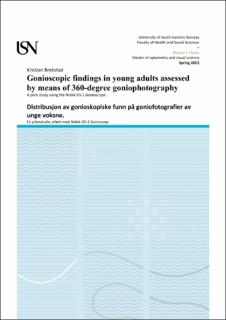| dc.description.abstract | Purpose: The primary objective was to investigate the visibility of angle structures and gonioscopic findings in four quadrants in young eyes by means of 360-degree goniophotography acquired by the Nidek GS-1 Gonioscope (GS-1).
Background: The anterior chambre angle is where the majority of the aqueous, produced in the ciliary body, is drained through the trabecular meshwork. Despite being dependent on the skill of the examiner, indirect gonioscopy remains the reference standard for a qualitative examination of the anterior chambre angle. This dependence on the skill of the examiner may be a limiting factor when performing qualitative studies on the ACA. The knowledge of normal variations such as trabecular pigmentations, iris processes, blood vessels and goniosynechiae is limited. Launched in September 2018, the Nidek GS-1 Gonioscope (Nidek, Japan) is a dedicated camera for goniophotography. It provides a 360-degree photograph of the anterior chambre angle.
Methods: The study had a cross-sectional design. Subjects was recruited from the students at the University of South-east Norway, campus Krona. Goniophotography was performed using the Nidek GS-1 automated gonioscope. Image quality and normal variations was registered and graded by an optometrist trained in the use of the gonio camera. Descriptive values included was central values (mean, mode) and spread of values (standard deviations, quantiles). Inferential statistics included correlation, and comparison between groups (Two-sample Wilcoxon, Friedman rank-sum).
Results: In total, 51 eyes of 27 subjects, 10 males and 17 females, were photographed. Mean age was 25,4 years. The percentage for best grade of image quality for the superior, inferior, temporal and nasal quadrant was 70%, 90%, 84% and 82% respectively, the difference was significant. There was no significant bilateral asymmetry. The most common grade for angle opening was 4 with the inferior quadrant having a significantly lower graded angle opening. Trabecular meshwork pigmentation was found in 96% of the eyes with the inferior quadrant being significantly the most pigmented. Iris processes was found in 86% of eyes. Here the superior quadrant, with significance, had the lowest grading. Blood vessels was found in 23% of the ACA while no goniosynechiae was observed.
Conclusion: The GS-1 provided images where the ACA structures was at least partially or fully focused for identification in 99% of the eyes. This makes it a highly suitable instrument for both scientific studies and for clinical use. The ciliary body was visible in 94% of the eyes, the inferior quadrant had the narrowest angle opening. Found in 96% of the eyes, trabecular meshwork pigmentation was the most common normal variation with the inferior quadrant being the most pigmented. Iris processes was found in 86% of the eyes with the superior quadrant having the lowest amount. BVs was found in 23% of the eyes without any quadrant differing and no goniosynechiae was found. There was no significant difference between the eyes.
Keywords: Anterior chambre angle, Nidek GS-1, trabecular pigmentation, gonioscopy | |
